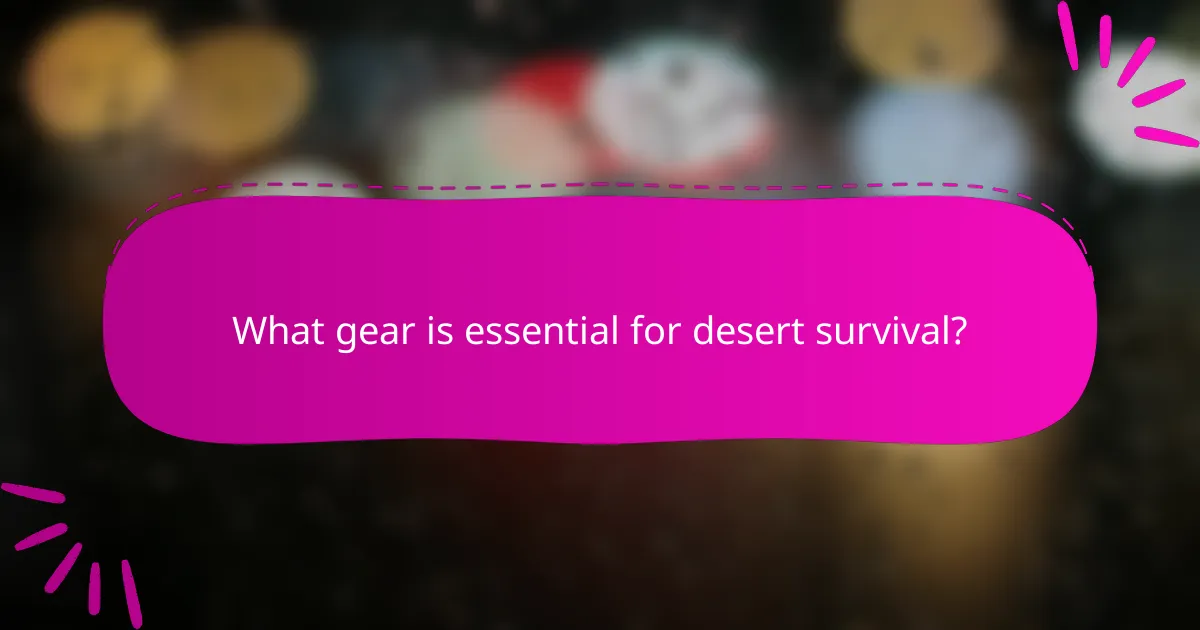The desert wyvern embodies the spirit of adventure in challenging terrains, where survival stories unfold against the backdrop of harsh conditions. Navigating these sandy landscapes requires skill, resilience, and an understanding of the environment, as adventurers face intense heat and limited resources. Engaging in activities like sandboarding and desert camping not only offers thrilling experiences but also sharpens essential survival techniques in this arid wilderness.

How to navigate challenging terrains in desert environments?
Navigating challenging terrains in desert environments requires a combination of skills, techniques, and the right equipment. Understanding the landscape, weather conditions, and using reliable navigation tools are crucial for successful travel in sandy areas.
Techniques for navigating sandy landscapes
When traversing sandy landscapes, it is essential to maintain a steady pace and choose your path wisely. Walking in the early morning or late afternoon can help avoid the hottest temperatures and reduce fatigue.
Utilize landmarks and natural features, such as rock formations or vegetation, to guide your route. If visibility is low, consider using a compass or GPS device to stay oriented.
Essential gear for desert navigation
Having the right gear is vital for navigating desert terrains effectively. A durable pair of hiking boots with good traction can prevent slips in loose sand, while lightweight, breathable clothing helps regulate body temperature.
Additionally, carrying a reliable compass, a GPS device, and a map of the area can enhance your navigation capabilities. A hydration system, such as a camelback or water bottles, is crucial to avoid dehydration in the arid climate.
Top navigation apps for desert terrains
Several navigation apps are designed specifically for outdoor activities in desert terrains. Apps like AllTrails and Gaia GPS provide detailed topographic maps and trail information, which can be invaluable for planning your route.
Other useful apps include Komoot, which offers route planning based on user-generated content, and Google Maps for basic navigation. Ensure your device is charged and consider downloading maps for offline use, as cell service may be limited in remote areas.

What survival stories highlight desert challenges?
Survival stories from desert environments often showcase the extreme challenges posed by harsh conditions, including intense heat, limited water sources, and treacherous terrains. These narratives reveal how individuals adapt and persevere against the odds in arid landscapes.
Notable survival stories from the Sahara
The Sahara Desert has been the backdrop for numerous gripping survival tales. One such story involves a group of travelers who became stranded during a sandstorm. They relied on their knowledge of the stars and local geography to navigate back to safety, demonstrating the importance of preparation and awareness in desert survival.
Another remarkable account is that of a lone hiker who survived for several days without food or water. He utilized natural resources, such as cacti, to stay hydrated and fashioned a makeshift shelter from the sun, highlighting the critical role of resourcefulness in dire situations.
Lessons learned from desert survival experiences
Desert survival experiences teach vital lessons about preparation and adaptability. One key takeaway is the necessity of carrying ample water and knowing how to ration it effectively. In extreme heat, even short periods without hydration can be dangerous.
Another important lesson is the value of navigation skills. Familiarity with the terrain and celestial navigation can be lifesaving, as many desert areas lack clear landmarks. Additionally, understanding weather patterns can help individuals avoid dangerous conditions, such as sudden storms or extreme temperature drops at night.

What are the best sandy adventure activities?
The best sandy adventure activities include sandboarding, desert camping, and guided tours, each offering unique experiences in challenging terrains. These activities allow adventurers to explore the beauty and thrill of sandy landscapes while honing their survival skills.
Sandboarding in the Mojave Desert
Sandboarding in the Mojave Desert is an exhilarating way to enjoy the vast dunes. Riders can glide down slopes that vary in steepness and length, making it suitable for both beginners and experienced boarders. Popular spots include the Kelso Dunes, where the sand can reach impressive heights.
To get started, ensure you have a suitable board, which can often be rented at local shops. It’s advisable to wear protective gear, such as knee pads and a helmet, to avoid injuries. Early morning or late afternoon sessions are ideal to avoid the heat and enjoy the best conditions.
Desert camping essentials for adventurers
Desert camping requires specific gear to ensure safety and comfort in harsh conditions. Essential items include a high-quality tent, sleeping bags rated for low temperatures, and plenty of water to stay hydrated. Sunscreen and protective clothing are crucial to guard against sunburn.
When planning your trip, consider the time of year and temperature fluctuations. Nights can be significantly cooler than days, so layering clothing is recommended. Always inform someone of your itinerary and check local regulations regarding camping areas.
Guided tours for desert exploration
Guided tours for desert exploration provide a structured way to experience the unique landscapes and wildlife of sandy terrains. These tours often include knowledgeable guides who can share insights about the ecosystem and history of the area. Options range from half-day excursions to multi-day adventures.
When choosing a tour, look for reputable companies that prioritize safety and environmental conservation. Many tours offer transportation, meals, and equipment, making them a convenient choice for those unfamiliar with the terrain. Booking in advance is recommended, especially during peak tourist seasons.

How to prepare for desert adventures?
Preparing for desert adventures involves understanding the unique challenges of sandy terrains and ensuring you have the right gear and knowledge. Key preparations include planning your route, packing essential supplies, and being aware of health risks associated with extreme conditions.
Checklist for desert adventure preparation
Start your preparation by creating a checklist that includes essential items for your desert adventure. Key items should include plenty of water, sun protection like hats and sunscreen, navigation tools, and a first aid kit.
- Water: At least 3-4 liters per person per day.
- Food: High-energy snacks like nuts and dried fruits.
- Clothing: Lightweight, breathable fabrics and sturdy footwear.
- Navigation: Maps, compass, or GPS devices.
- Emergency gear: Whistle, flashlight, and a multi-tool.
Review your checklist regularly to ensure you have everything needed for a safe and enjoyable experience in the desert.
Health precautions for desert activities
Health precautions are crucial when engaging in activities in desert environments. Dehydration is a major risk, so drink water frequently, even if you don’t feel thirsty. It’s advisable to take breaks in shaded areas during the hottest parts of the day.
Additionally, be aware of the signs of heat exhaustion, which can include dizziness, nausea, and excessive sweating. If you experience these symptoms, seek shade and hydrate immediately. Wearing protective clothing and applying sunscreen can help prevent sunburn and heat-related illnesses.
Lastly, consider informing someone about your plans and expected return time, especially if you are venturing into remote areas. This ensures that help can be summoned if needed.

What are the key survival skills for desert terrains?
Key survival skills for desert terrains include effective water sourcing, building appropriate shelters, and navigating extreme temperatures. Mastering these skills can significantly enhance your chances of survival in harsh, sandy environments.
Water sourcing techniques in arid regions
Finding water in arid regions is crucial for survival. Techniques include digging for groundwater, collecting dew, and utilizing local flora, such as cacti, which can provide moisture. Always prioritize locations where vegetation is abundant, as this often indicates nearby water sources.
When digging for groundwater, aim for areas where the soil is damp or where plants are thriving. Use a container to collect water and purify it by boiling or using water purification tablets when possible. Remember, rationing water is essential; consume only what you need to stay hydrated.
Building shelter in sandy environments
Constructing a shelter in sandy environments requires creativity and resourcefulness. Look for natural formations like rocks or shrubs to provide shade and wind protection. If none are available, use materials such as branches, leaves, or even sand to create a temporary structure.
When building a shelter, ensure it is low to the ground to minimize exposure to wind and heat. A simple lean-to made from branches can offer adequate protection. Always position your shelter away from potential hazards, such as flash flood areas, and consider the sun’s path to maximize shade during the hottest parts of the day.

What gear is essential for desert survival?
Essential gear for desert survival includes items that protect against extreme heat, provide hydration, and offer shelter. Key components are a reliable water supply, sun protection, and tools for navigation and first aid.
Top-rated survival kits for desert conditions
When selecting a survival kit for desert conditions, prioritize kits that include water purification systems, emergency food rations, and first aid supplies. Look for kits that are compact and lightweight, making them easy to carry during sandy adventures.
Some top-rated options include the Adventure Medical Kits’ Mountain Series and the Ready America 70280 Emergency Kit. These kits typically contain essential items like multi-tools, signaling devices, and thermal blankets, all crucial for survival in harsh environments.
Best clothing for desert adventures
Choosing the right clothing for desert adventures is vital for protection against sun exposure and heat. Lightweight, breathable fabrics that wick moisture away from the skin are ideal. Look for long-sleeved shirts and pants made from materials like nylon or polyester.
Additionally, opt for light-colored clothing to reflect sunlight and a wide-brimmed hat for added sun protection. Don’t forget to wear sturdy, breathable footwear that can handle rocky and sandy terrains while providing adequate support.

How do desert ecosystems impact survival strategies?
Desert ecosystems significantly influence survival strategies by presenting extreme conditions that require specialized adaptations. Organisms in these environments must efficiently manage water, temperature, and food sources to thrive.
Understanding desert flora and fauna
Desert flora and fauna have evolved unique adaptations to survive in harsh climates. Plants like cacti and succulents store water in their tissues, while animals such as camels and reptiles have developed physiological traits to minimize water loss and regulate body temperature.
In deserts, the biodiversity is often lower than in other ecosystems, but the species present are highly specialized. For example, nocturnal animals avoid daytime heat, while many plants have deep root systems to access underground moisture. Understanding these adaptations is crucial for survival in sandy terrains.
When navigating desert environments, it is essential to recognize the signs of flora and fauna. Familiarity with local species can aid in finding food and water sources, as well as avoiding potential dangers, such as venomous snakes or toxic plants. Always carry a field guide or use a reliable app to identify local wildlife and vegetation.










